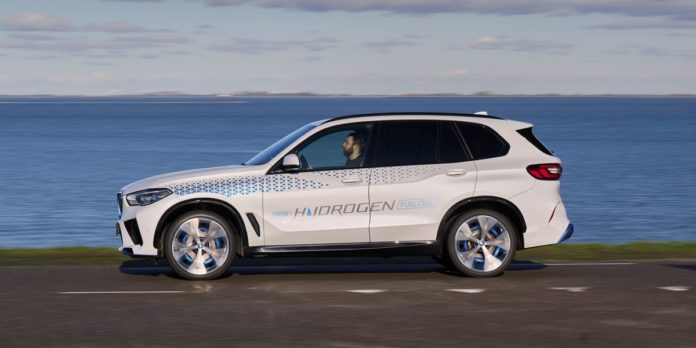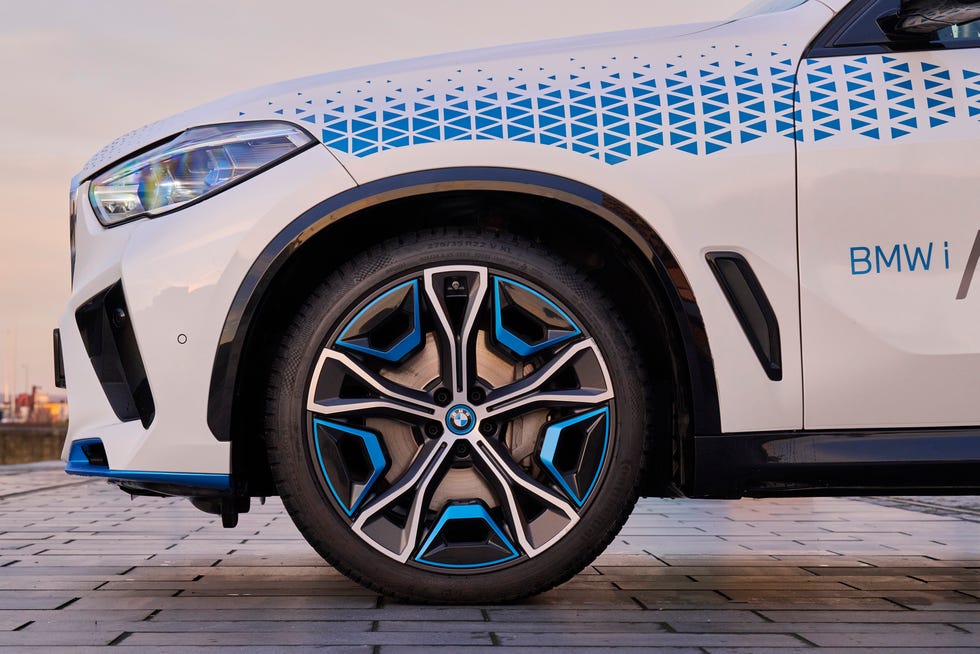It will take a range of solutions to realize the carbon-neutral operations many automakers, including BMW, have pledged to reach by the middle of this century. Battery-electric vehicles (BEVs) will shoulder the bulk of the clean-energy load going forward, but the German manufacturer is not alone in believing that hydrogen-powered fuel-cell vehicles (FCVs) will be an essential part of the mix. Honda, Hyundai, and Toyota also share that sentiment with their current and upcoming FCV models. After driving a new iX5 FCV prototype in Belgium, we came away thinking that BMW may be onto something, even if that something likely won’t come to fruition for another decade or two.
Fewer than 100 iX5s will be built this year as part of a demonstration fleet for various regulatory bodies and marketing endeavors. Only a small handful will come to the United States, where—unlike Central Europe and parts of Asia—hydrogen infrastructure is practically nonexistent outside of California. Production entails shipping an X5 from its Spartanburg, South Carolina, birthplace to the BMW Research and Innovation Center in Munich. There, they fit a new floor to accommodate the iX5’s two cylindrical, carbon-fiber hydrogen tanks nestled in its center tunnel and under the rear seat. Fuel capacity amounts to about 16 pounds of gaseous hydrogen pressurized to 10,150 psi, which is good for around 310 miles of estimated range per Europe’s optimistic WTLP methodology (that equates to about 260 miles of range in the U.S., according to the EPA’s cycles). Unlike with a BEV, refilling the iX5 at one of the hydrogen stations around Antwerp only takes a few minutes and will be familiar to anyone who has ever pumped their own gas.
Under the iX5’s cargo area is a rear drive axle and current-excited synchronous motor from a BMW iX. Sitting atop it is 400-volt lithium-ion battery with about 2.0 kWh of usable capacity, which exists as a power buffer to the fuel cell to aid in acceleration and also to recoup energy under braking. The fuel-cell stack itself resides under the iX5’s hood and includes core cell elements from BMW’s longtime FCV partner, Toyota. BMW developed the rest of the assembly, including the stack’s cooler and humidifier that optimize the system’s air quality, plus a powerful compressor to quickly shove oxygen into the cells’ membranes, where the main chemical reaction takes place. According to BMW, these enhancements result in both quick response to accelerator inputs and the fuel cell’s ability to continuously run at maximum power. As with all FCVs, electricity and water vapor are the only byproducts, with total system output a respectable 395 horsepower.
You’ll be able to spot the iX5 by its many blue accents and the stickers running across its hood and down its flanks. From behind the wheel, the experience is wholly uneventful, which is the point. This vehicle drives exactly as you’d expect an electric X5 to—smooth, quiet, and refined. Its steering is pleasantly direct, and its air springs and adaptive dampers return nicely balanced body motions. Ride comfort on our sample car’s 20-inch run-flat winter tires was good, though the standard 22-inch Pirelli P Zeros surely will degrade that a bit. Several drive modes vary the iX5’s sportiness accordingly, while paddles on its steering wheel adjust the regenerative braking from a little to quite a lot. Mat the right pedal, and the Bimmer accelerates briskly with the low-end punch of a BEV, thanks in part to the fuel cells’ ability to simultaneously contribute energy to the traction motor and help maintain a high state of charge for the battery. Traffic congestion during our drive provided us with zero opportunity for fun, but BMW’s claims of acceleration to 62 mph in around six seconds and a 115-mph top speed are entirely believable.
Along with being easier to refuel, the iX5 highlights additional benefits of FCVs over comparable BEVs. For one, fuel-cell vehicles tend to be lighter, mostly because they require only a modestly sized battery; BMW says the iX5’s curb weight is similar to that of the X5 plug-in hybrid, the last of which we tested weighed 5627 pounds. Of course, the similarly sized electric iX, with its large 105.2-kWh pack, is barely heavier, but its structure employs more lightweight materials than the X5’s that are worth a couple-hundred-pound weight reduction. Another benefit for FCVs is that their smaller battery means they require substantially fewer elements that are now in high demand to produce, such as lithium, cobalt, and nickel, though small amounts of platinum are needed for the fuel cell itself. The performance of fuel cells is more stable in extreme temperatures, too, particularly in the cold. While freezing water emissions inside of a fuel cell can indeed be a problem, BMW says the iX5 overcomes this by employing compressed air to blast residual water out of its cells and into drainage circuits. As for those wondering what happened to BMW’s previous work on hydrogen internal-combustion engines, technical issues and the inherent similarities between FCVs and BEVs have killed that business case.
Proponents of FCVs argue that because of their strengths, especially their reduced mass and lessened need for exotic materials, fuel cells scale up well in larger applications, such as heavy trucks and ships with ample space to house sizable storage tanks. Big industries such as steel processing are beginning to utilize hydrogen as well, and BMW is betting that such applications will be key to the future development of FCVs. Indeed, the company’s strategy rests on hydrogen becoming more practical (and affordable) for transportation use as its popularity in other sectors increases. “It’s all about timing,” says Oliver Zipse, chairman of BMW’s Board of Management, likening a coming trigger point from hydrogen’s expected broader adoption to what lithium-ion batteries have done for BEVs.
But don’t expect to see an iX5 in your driveway anytime soon. BMW considers this FCV pilot program akin to its initial limited rollout of BEVs, which included the first Mini E in 2009 and the BMW ActiveE in 2012. Yet even as the company develops versatile vehicle architectures to support fuel-cell powertrains, FCVs will primarily be a complementary—and likely subsidized—technology in markets that are willing to tackle the convoluted economics of getting hydrogen to consumers. Ongoing supply disruptions in Europe, for example, have significantly increased the cost of hydrogen well above that of gasoline and diesel fuel on a per-mile basis. Of course, none of this helps with long-term sustainability unless hydrogen is produced using clean energy sources such as wind, solar, and nuclear, among others. In short, as compelling as BMW’s hydrogen tech may be, it’s only a small piece in the future energy puzzle.
Technical Editor
Mike Sutton is an editor, writer, test driver, and general car nerd who has contributed to Car and Driver‘s reverent and irreverent passion for the automobile since 2008. A native Michigander from suburban Detroit, he enjoys the outdoors and complaining about the weather, has an affection for off-road vehicles, and believes in federal protection for naturally aspirated engines.


